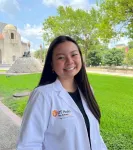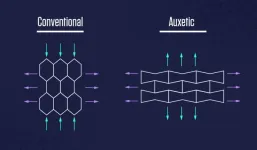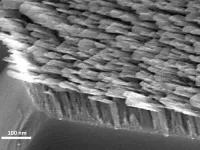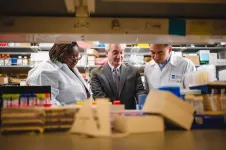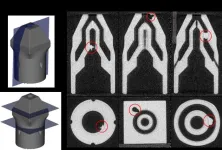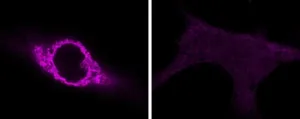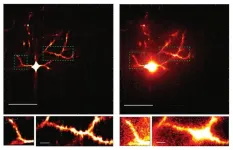(Press-News.org) Getting into graduate school to become a doctor or a dentist is difficult. By some estimates, only about 37% to 42% of students who apply to medical or dental school are accepted.
To help pre-medical and -dental students achieve their dreams, UT Arlington created a program called the Health Professions Advisory Committee (HPAC). The odds of graduate school admission for students participating in HPAC is significantly higher than average, with an estimated 85% succeeding.
This is just one of several UT Arlington initiatives helping alleviate the shortages of health care professionals in Texas, particularly in rural areas.
“Our numbers vary slightly every year, but it’s so exciting to see so many of our students achieving their dream of going to medical or dental school,” said Sandy Hobart, health professions advisor and HPAC chair. The program is run through UTA’s College of Science, which includes the departments of Biology, Chemistry, Mathematics, and Physics—the core subjects pre-medical and -dental students must take before applying to graduate school.
To participate in HPAC, students must be either an alumnus or a current UTA student with a minimum grade point average of 3.25. The program also works with attending UTA as postbaccalaureates to take additional courses required for graduate school in the health professions.
Those interested must submit information on why they want to become a doctor or a dentist, explain their relevant experiences and submit letters of recommendation. A designated group of faculty and staff across UTA then completes a holistic evaluation of each student to see if they’re prepared to apply to medical or dental school in the upcoming cycle. Not all students who apply are ultimately accepted; however, there is no limit to the number of students who can participate each year.
“HPAC is one great way for students to stand out in the medical school application process,” said Nina Nguyen, a third-year medical student at UT Health San Antonio’s Long School of Medicine. Nguyen graduated from Bowie High School in Arlington before earning a degree in biochemistry from UTA.
All students who submit an HPAC application receive feedback and mentoring from Hobart throughout the medical and dental school application process. As part of this supportive approach, accepted students also receive an interview and letter of recommendation for their graduate school applications from the HPAC committee.
“Often times, medical school applicants have similar grades, MCAT scores, interests and volunteering experiences,” Nguyen said. “HPAC provides one additional letter that applicants can use to allow them to stand out against the crowd. Since the HPAC letter is an accumulative recommendation from multiple faculty and staff, it carries significant weight. Personally, I think my HPAC letter helped reinforce what was already on my application.”
“Many of our students are first-generation college students and need guidance on how to achieve their goal of becoming a physician or a dentist,” said Laura Mydlarz, associate dean of the College of Science and a distinguished professor of biology. She works closely with many of the students taking biology coursework as part of their graduate school prerequisites.
“Seeing my students not only reach their goals, but also grow as people and feel confident pursuing these goals is one of the most fulfilling parts of my career,” said Hobart (’07 BS, Biology, Chemistry). “Some members from our earlier cohorts of students are now practicing doctors and dentists. I’m excited to see all the good they do to improve the lives of others in our communities.”
END
UTA program helps students achieve medical school dreams
85% of students in novel pre-med, pre-dental program admitted to graduate school
2024-06-04
ELSE PRESS RELEASES FROM THIS DATE:
Rocky shores of Pacific Northwest show low resilience to changes in climate
2024-06-04
CORVALLIS, Ore. – A 15-year period ending in 2020 that included a marine heat wave and a sea star wasting disease epidemic saw major changes in the groups of organisms that live along the rocky shores of the Pacific Northwest.
The study by Oregon State University scientists, involving four capes in Oregon and California, suggests these communities of species may have low resilience to climate change. Findings were published Monday in Nature Ecology & Evolution and.
Researchers learned that ...
A new way of designing auxetic materials
2024-06-04
Imagine pulling on the long ends of a rectangular piece of rubber.
It should become narrower and thinner.
But what if, instead, it got wider and fatter?
Now, push in on those same ends. What if the rubber became narrower and thinner?
Such common-sense-defying materials do exist. They’re called auxetics, and they have a raft of unique properties that make them well-suited for sneaker insoles, bomb-resilient buildings, car bumpers and clothing.
Despite this great potential, auxetic products have been slow to market. Researchers at the National Institute of Standards and Technology (NIST) and the University of Chicago hope to change this.
In a new study published ...
Neurocognitively-defined subtypes in bipolar disorder: a path to more personalized treatments
2024-06-04
The Brain & Behavior Research Foundation (BBRF) is hosting a free webinar, “Neurocognitively-Defined Subtypes in Bipolar Disorder: A Path to More Personalized Treatments” on Tuesday, June 11, 2024, at 2:00 pm ET. The presenter, Katherine E. Burdick, PhD, is the Jonathan F. Borus, MD Distinguished Chair in Psychiatry and the Vice Chair for Research in Psychiatry at Brigham and Women’s Hospital. She is the Director of the Mood and Psychosis Research Program at BWH and a Professor at Harvard Medical ...
Shining a light on molecules: L-shaped metamaterials can control light direction
2024-06-04
UNIVERSITY PARK, Pa. — Polarized light waves spin clockwise or counterclockwise as they travel, with one direction behaving differently than the other as it interacts with molecules. This directionality, called chirality or handedness, could provide a way to identify and sort specific molecules for use in biomedicine applications, but researchers have had limited control over the direction of the waves — until now.
Using metamaterials, a team of electrical engineering researchers from Penn State and the University of Nebraska-Lincoln ...
Wistar scientists develop novel antibody treatment for kidney cancer
2024-06-04
PHILADELPHIA — (June 04, 2024) — Advanced clear cell renal cell carcinoma (ccRCC) is a deadly form of kidney cancer with few treatment options; even with new immunotherapies, only around one in 10 patients ultimately survive.
Antibody therapies called bispecific T cell engagers (BTEs) have emerged as effective treatments for some blood cancers but have been more difficult to develop for solid tumors. While clinically successful, first-generation BTEs suffer a short half-life. Now, Wistar scientists have built upon BTE technology to develop new and improved recombinant and synthetic ...
Virus that causes COVID-19 can remain in sperm for 110 days after infection
2024-06-04
Researchers at the University of São Paulo (USP) in Brazil have shown for the first time that SARS-CoV-2, the virus that causes COVID-19, can remain in the sperm of patients for up to 90 days after hospital discharge and up to 110 days after the initial infection, reducing semen quality. The study is reported in an article published in the journal Andrology. The authors suggest that people who plan to have children should observe a period of “quarantine” after recovering ...
Researchers use machine learning to detect defects in additive manufacturing
2024-06-04
Researchers at the University of Illinois Urbana-Champaign have developed a new method for detecting defects in additively manufactured components.
One of the most important tasks in any factory is to determine whether a manufactured component is free of defects. In additive manufacturing (3D printing), it can be particularly challenging to find defects, because additive manufacturing can make components that have complex three-dimensional shapes and important internal features that are not easily observed.
The novel technology uses deep machine ...
Rare disease’s DNA-damaging mutation could have consequences for more common conditions
2024-06-04
TREX1 is a gene that is supposed to direct the maintenance of the entire body’s DNA, but new research shows that when people are born with mutated TREX1, it causes catastrophic damage to the DNA over time, resulting in a deadly rare disease called retinal vasculopathy with cerebral leukoencephalopathy (RVCL). Published in Nature Communications, the research was led by teams at the Perelman School of Medicine at the University of Pennsylvania and the Brain Research Institute at Niigata University in Japan.
While it was already known that a mutation in TREX1 was behind RVCL, the mechanism by which ...
Exploring three frontiers in marine biomass and blue carbon capture
2024-06-04
A new study offers first-time insights into three emerging climate innovations to safeguard or increase the carbon naturally captured by ocean and coastal ecosystems: rapid interventions to save the Great Barrier Reef, satellite-tracked kelp beds in the deep ocean, and seagrass nurseries in the United Kingdom. The research, published in Environmental Science & Policy and co-authored by leading climate scholars at Boston University, Aarhus University, and the University of Sussex Business School, advances knowledge of understudied interventions in marine ...
Microscope system sharpens scientists’ view of neural circuit connections
2024-06-04
The brain’s ability to learn comes from “plasticity,” in which neurons constantly edit and remodel the tiny connections called synapses that they make with other neurons to form circuits. To study plasticity, neuroscientists seek to track it at high resolution across whole cells, but plasticity doesn’t wait for slow microscopes to keep pace and brain tissue is notorious for scattering light and making images fuzzy. In a paper in Scientific Reports, a collaboration of MIT engineers and neuroscientists describes a new microscopy system designed for fast, clear, and frequent imaging of the living brain.
The system, ...
LAST 30 PRESS RELEASES:
Electrodes created using light
Second-hand gift-giving is a well-deliberated decision
How human interaction drove evolution to make bears less aggressive
National Poll: Few parents offer teens guidance on healthy eating during holiday season
Cannabis derivatives could provide new ovarian cancer treatments
Raising strong yeast as a petroleum substitute
Clues to the origin of hot Jupiters hidden in their orbits
Canada’s reduced pledge to Global Fund will impact domestic health
1 in 4 children with major traumatic injuries not cared for in pediatric trauma centres
Duke and Duke-NUS’ joint cross-population research to uncover "East-West" differences in disease and care
Scientists to ‘spy’ on cancer- immune cell interactions using quantum technology breakthrough
Tech savvy users have most digital concerns
Making lighter work of calculating fluid and heat flow
Normalizing blood sugar can halve heart attack risk
Lowering blood sugar cuts heart attack risk in people with prediabetes
Study links genetic variants to risk of blinding eye disease in premature infants
Non-opioid ‘pain sponge’ therapy halts cartilage degeneration and relieves chronic pain
AI can pick up cultural values by mimicking how kids learn
China’s ecological redlines offer fast track to 30 x 30 global conservation goal
Invisible indoor threats: emerging household contaminants and their growing risks to human health
Adding antibody treatment to chemo boosts outcomes for children with rare cancer
Germline pathogenic variants among women without a history of breast cancer
Tanning beds triple melanoma risk, potentially causing broad DNA damage
Unique bond identified as key to viral infection speed
Indoor tanning makes youthful skin much older on a genetic level
Mouse model sheds new light on the causes and potential solutions to human GI problems linked to muscular dystrophy
The Journal of Nuclear Medicine ahead-of-print tip sheet: December 12, 2025
Smarter tools for peering into the microscopic world
Applications open for funding to conduct research in the Kinsey Institute archives
Global measure underestimates the severity of food insecurity
[Press-News.org] UTA program helps students achieve medical school dreams85% of students in novel pre-med, pre-dental program admitted to graduate school
